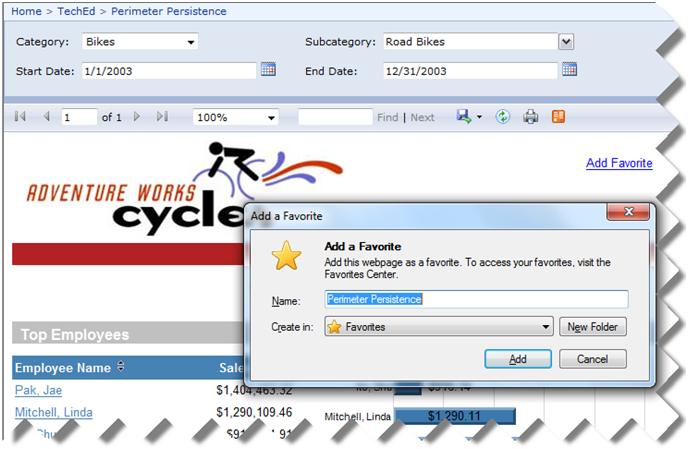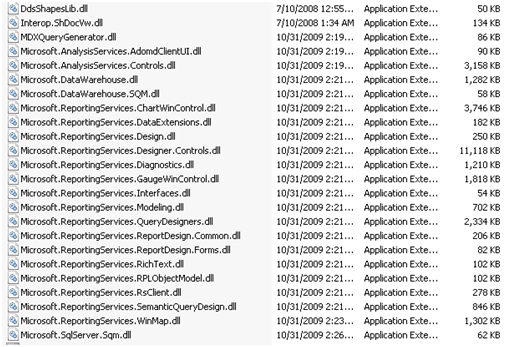Feeding Reports by Code
In a previous blog, I introduced one of the new SSRS 2008 R2 feature: reports as data feeds. As I said, the R2 release will include a new Atom Data Feed renderer to produce an Atom service document (*.atomsvc) which defines a feed(s) per data region. I also said that the main scenario for report feeds was to let the PowerPivot add-in for Excel (previously known as Gemini) consume report data. Recently, I’ve watched the interesting Pablo Castro’s “ADO.NET Data Services: What’s new with the RESTful data services framework” presentation which got me inspired to find a way to consume a report data feed programmatically outside PowerPivot. Since the Atom feed format is pre-defined, a custom application could benefit from this scenario to retrieve and manipulate the report data. In this case, an atom feed may be preferable than other format, such as CSV, because data is exposed as properties instead of columns.
So, I embark on a journey to write a small Silverlight app, RSFeedReader, that reads and displays a report feed. You will need Visual Studio 2010 to open the RSFeedReader source code. Before running the application, you may need to deploy the clientaccesspolicy.xml file included in the source to the IIS root, such as c:\inetpub\wwwroot or C:\inetpub\wwwroot\wss\VirtualDirectories\80 if you have SharePoint installed on port 80, to grant the application rights to connect to Reporting Services. If you don’t, Silverlight would treat the application URL, which runs under the local ASP.NET IIS server, and Report Server URL as two different domains and it will throw a security exception.
You can enter a report feed in the textbox and hit Fetch. The data feed results are shown in the grid. Similar to PowerPivot, each row represents a row in the report data region but the properties are stacked vertically instead of horizontally. The first column shows the entry identifier which identifies the row in the data region and the second column shows the values in that row. The Generating Data Feeds from Reports BOL topic covers the technical details of report feeds pretty well. Basically, the feed URL must include a unique identifier which you obtain from the Atom service document when you export the report to the Atom Data Feed format. The default feed URL points the matrix region in the Company Sales report although you can’t tell this from the feed URL. Again, you need to get the DataFeed identifier for the region from service document after exporting to Atom. If you request the report data feed in the browser, you will see the resulting XML. The most interesting information is included in the m:properties element.
Unlike SharePoint, Reporting Services doesn’t provide a WCF endpoint, such as ListData.svc, so you can’t generate a Visual Studio proxy (unless you do it manually). Instead, RsFeedReader, uses WebClient to submit the URL request to Reporting Services to obtain the feed.
protected void LoadFeed(string uri)
{
WebClient wc = new WebClient();
wc.OpenReadCompleted += new OpenReadCompletedEventHandler(wc_OpenReadCompleted);
Uri feedUri = new Uri(uri, UriKind.Absolute);
wc.OpenReadAsync(feedUri);
}
private void wc_OpenReadCompleted(object sender, OpenReadCompletedEventArgs e)
{
if (e.Error != null)
{
txtFeedLoc.Text = “Error load report data feed. “ + e.Error.Message;
return;
}
using (Stream s = e.Result)
{
SyndicationFeed feed;
using (XmlReader reader = XmlReader.Create(s))
{
// read the feed
feed = SyndicationFeed.Load(reader);
var posts = from item in feed.Items
select new FeedEntry(item.Id, (XmlSyndicationContent)item.Content);
// show feeds in grid
dGrid.ItemsSource = posts;
dGrid.Visibility = Visibility.Visible;
}
}
}
Once the asynchronous call completes, RsFeedReader loops through the feed entry elements and populates a collection of FeedEntry objects which I bind to the grid. The FeedEntry class parses the content element of the entry (where the properties are located) and exposes them as a ContentProperties object (not shown) which I bind to the nested grid in the LoadingRow event of the outer grid.
It probably won’t be long before various custom applications start popping up that lets end users subscribe to feeds, such as to let the end user get notified when report content changes.






